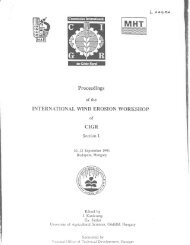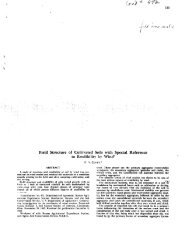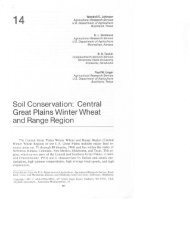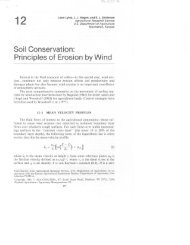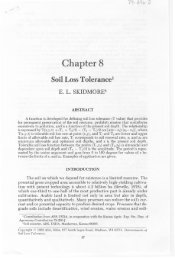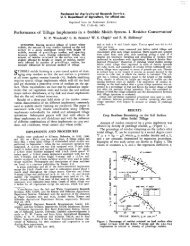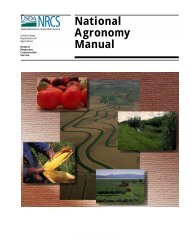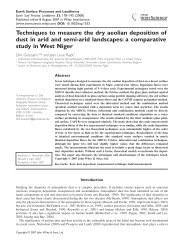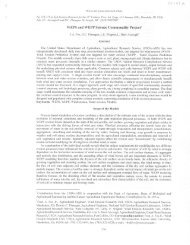Soil quality of two Kansas soils as influenced by the Conservation ...
Soil quality of two Kansas soils as influenced by the Conservation ...
Soil quality of two Kansas soils as influenced by the Conservation ...
You also want an ePaper? Increase the reach of your titles
YUMPU automatically turns print PDFs into web optimized ePapers that Google loves.
<strong>Soil</strong> <strong>quality</strong> <strong>of</strong> <strong>two</strong> <strong>Kans<strong>as</strong></strong> <strong>soils</strong> <strong>as</strong><strong>influenced</strong> <strong>by</strong> <strong>the</strong> <strong>Conservation</strong> ReserveProgramX. Huang, E.L. Skidmore, and G.L. TibkeABSTRACT: Achieving and maintaining a good soil <strong>quality</strong> is essential for sustaining agriculturalproduction in an economically viable and environmentally safe manner. The transition <strong>of</strong> landmanagement provides an opportunity to me<strong>as</strong>ure soil-<strong>quality</strong> indicators to quantify <strong>the</strong> effects <strong>of</strong>those management practices. This study compared soil chemical and physical properties after ioyears <strong>of</strong> gr<strong>as</strong>s on <strong>Conservation</strong> Reserve Program (CRP) land with those in continuously croppedland (CCL). The sample sites, located in central <strong>Kans<strong>as</strong></strong>, have <strong>two</strong> mapping units, Harney silt loam(fine, montmorillonitic, mesic Typic Arigiustolls) and Naron fine sandy loam (fine-loamy, mixed,<strong>the</strong>rmic Udic Argiustolls). <strong>Soil</strong> samples were collected at <strong>two</strong> depth increments, o to 5 cm and 5to io cm. <strong>Soil</strong>-<strong>quality</strong> indicators me<strong>as</strong>ured were soil acidity (pH), exchangeable cations,nutrients, total carbon, structure, and aggregation. <strong>Soil</strong> pH w<strong>as</strong> significantly lower in CCL than inCRP. <strong>Soil</strong> total C and N in <strong>the</strong> surface layer (0 to 5 cm) w<strong>as</strong> much greater than in <strong>the</strong> deeper layer(s to io cm) in <strong>the</strong> CRP site. The m<strong>as</strong>s <strong>of</strong> total carbon <strong>of</strong> Naron soil w<strong>as</strong> significantly higher foro to 5 cm and lower for 5 to io cm depth in CRP land than in CCL. However, <strong>the</strong> m<strong>as</strong>s <strong>of</strong> totalcarbon <strong>of</strong> Harney soil w<strong>as</strong> significantly higher in no-tilled CCL than in CRP. Bulk densitysignificantly incre<strong>as</strong>ed in CCL. B<strong>as</strong>ed on dry and wet aggregate stability analysis, <strong>the</strong> resultsindicated that CRP land had a greater resistance to erosion <strong>by</strong> both water and wind than CCL. Theimprovements in soil <strong>quality</strong> resulting from CRP included reducing soil acidification, alleviatingcompaction, and reducing topsoil susceptibility to erosion. However, when CRP w<strong>as</strong> taken out forcrop production with conventional tillage, total carbon in <strong>the</strong> surface layer (0 to 5cm) andaggregate stability gradually decre<strong>as</strong>ed. This suggested that appropriate land managementpractices are needed to extend residual benefit from CRP on soil <strong>quality</strong>.Keywords: Aggregate stability, CRP, soil <strong>quality</strong>, soil total carbon, wind erosionContinuous cultivation and addition <strong>of</strong>ammonical fertilizers are generallythought to decre<strong>as</strong>e soil <strong>quality</strong> <strong>by</strong> alteringsoil acidity, depleting soil organicmatter, disrupting soil structure, andreducing biological activity (Staben et al.1997, Hill 1990, Lal et al. 1994). In addition,soil under continuous production is vulnerableto accelerated erosion. To reduce soilerosion and improve soil <strong>quality</strong>, <strong>the</strong> U.S.Congress enacted <strong>the</strong> <strong>Conservation</strong> ReserveProgram (CRP) in 1985. CRP put highlyerodible (erodibility index 2 8) and environmentallysensitive lands into gr<strong>as</strong>s or o<strong>the</strong>rperennial planting. Nationally, 14.8 millionhectares were enrolled in CRP in <strong>the</strong> first 12signups, with nearly 60% <strong>of</strong> CRP acreagelocated in <strong>the</strong> Great Plains and 1.13 millionhectares in <strong>Kans<strong>as</strong></strong> alone (Osborn 1993,Lindstrom et al. 1994).Many studies were reported that soilerosion h<strong>as</strong> been greatly reduced with permanentvegetative cover in CRF'. Airbornedust in <strong>the</strong> sou<strong>the</strong>rn High Plains <strong>of</strong>Tex<strong>as</strong> w<strong>as</strong>sigdicantly reduced because <strong>of</strong> CRP (Ervinand Lee 1994). Through remote sensingimaging, Wu et al. (1997) found higher soilfertility and lower soil erodibility in CRPland, compared with continuous cropland inFinney County, <strong>Kans<strong>as</strong></strong>. Davie and Lant(1994) studied <strong>two</strong> watersheds in sou<strong>the</strong>rnIllinois and reported that CRP land showeddecre<strong>as</strong>es in erosion <strong>of</strong> 24% in one watershedand 37% in ano<strong>the</strong>r. Less erosion <strong>by</strong> run<strong>of</strong>f in<strong>the</strong> first year <strong>of</strong> conversion &om CRP w<strong>as</strong>reported <strong>by</strong> Gilley et al. (1997).In addition to erosion reduction, CRPsoil-<strong>quality</strong> improvement w<strong>as</strong> noted <strong>by</strong>incre<strong>as</strong>ing soil organic matter and soil tilth(Staben et al. 1997). <strong>Soil</strong> structure improveswhen continuously cultivated land is put intogr<strong>as</strong>s (Lindstrom et al. 1994). Karlen et al.(1999) reported that CRP sites had a higherpercentage <strong>of</strong> water-stable soil aggregatesthan cropland sites.Karlen et al. (1999) me<strong>as</strong>ured total organicC in paired CRP and cropland sites in Iowa,Minnesota, North Dakota, and W<strong>as</strong>hington.In all states, microbial biom<strong>as</strong>s carbon w<strong>as</strong>17% to 64% higher at CRP sites than at croplandor fallow sites, while nitrate-N w<strong>as</strong> 18%to 74% higher in cropland than CRP sites.This multistate project showed that severalsoil-<strong>quality</strong> indicators were improved <strong>by</strong> placinghighly erodible cropland into perennialgr<strong>as</strong>s.Gebhart et al. (1994) analyzed soil organicmatter levels <strong>of</strong> <strong>soils</strong> sampled &om cropland,native p<strong>as</strong>ture, and five-year-old CRP sites inTex<strong>as</strong>, <strong>Kans<strong>as</strong></strong>, and Nebr<strong>as</strong>ka.They found thatsoil organic matter levels for cropland, nativep<strong>as</strong>ture, and five-year old CRP sites were59.2,63.1, and 90.8 metric tons C ha-' in <strong>the</strong>surface 300 cm, respectively. However, Stabenet al. (1997) found no sigrufcant aerencesin total organic carbon between CRP andwheat-fallow <strong>soils</strong> in e<strong>as</strong>tern W<strong>as</strong>hington on <strong>as</strong>ilt loam. B<strong>as</strong>ed on C mineralization, <strong>the</strong>y did,however, suggest that a higher-<strong>quality</strong> soilorganic matter w<strong>as</strong> found on CRP land.<strong>Soil</strong>-<strong>quality</strong> benefits derived &om CRP mayrapidly decline once an area is tilled and <strong>the</strong>nleft fallow during <strong>the</strong> noncropped period(Gilley et al. 1997).<strong>Soil</strong> biological properties are sensitiveindicators that reflect land-practice change(Huggins et al. 1998, Karlen et al. 1999).Karlen and Parkin (1996) found microbialbiom<strong>as</strong>s w<strong>as</strong> sigrufcantly higher for CRPthan for cultivated are<strong>as</strong> and suggested soil<strong>quality</strong> w<strong>as</strong> improved &om <strong>the</strong> biological344JOURNALOF SOIL AND WATER CONSERVATION N/D 2002Reprihted &om <strong>the</strong> Journal <strong>of</strong> <strong>Soil</strong> and Wafer ComervationVolume 57, Number 6Copyight 0 2002 <strong>Soil</strong> and Water <strong>Conservation</strong> Society
perspective. Staben et al. (1997) investigatedmicrobial <strong>as</strong>pects <strong>of</strong> soil <strong>quality</strong> betweenCRP and wheat-fallow <strong>soils</strong> on a silt loam ine<strong>as</strong>tern W<strong>as</strong>hington. They concluded thatactive bacterial biom<strong>as</strong>s and potential enzymeactivities were higher in <strong>the</strong> CRP soil than in<strong>the</strong> wheat-fallow soil.The need is urgent to understand longtermland-management effects on soil <strong>quality</strong>at various scales-pedon and point, to fieldand plot, to farm and watershed, and toregional and national levels (Karlen et al.1998). Expiration <strong>of</strong> CRP contracts andsubsequent return <strong>of</strong> highly erodible lands tocontinuous cropping concerns policymakers,conservationists, and farmers (Ervin 1993,Osborn 1993, Lindstrom et al. 1994).Knowledge <strong>of</strong> changes in soil properties during10 years <strong>of</strong> CRP enrollment is importantfor evaluating <strong>the</strong> program effectiveness.Also, <strong>the</strong> return <strong>of</strong> CRP land to cultivationprovides a chance to evaluate changes inchemical and physical properties for soil<strong>quality</strong>.The objectives <strong>of</strong> this study were to comparesoil properties between 10 years <strong>of</strong> gr<strong>as</strong>splanting<strong>Conservation</strong> Reserve Program landand adjacent continuously cropped land, andto evaluate effects <strong>of</strong> <strong>the</strong> <strong>Conservation</strong>Reserve Program on soil <strong>quality</strong> during its10-year enrollment and its transition backinto crop production.Methods and MaterialsField description. Two fields located in central<strong>Kans<strong>as</strong></strong> were selected <strong>as</strong> study sites. Onew<strong>as</strong> near Larned <strong>of</strong> Pawnee County.The soil w<strong>as</strong> deep, well-drained, Harney siltloam (fine, montmorillonitic, mesic TypicArigiustolls, 21% sand, 64% silt, and 15% clayat 0 to 10 cm depth).The sampling site forCRP w<strong>as</strong> about 150 m fbm CCL at this1ocation.The CCL w<strong>as</strong> in nonirrigated, notill,wheat-corn [Zea mays L.] rotation for fiveyears before <strong>the</strong> beginning <strong>of</strong> this study.Theo<strong>the</strong>r site w<strong>as</strong> located near Zenith <strong>of</strong> StaffordCounty.The soil w<strong>as</strong> Naron, fine, sandy loam(fine-loamy, mixed, <strong>the</strong>rmic Udic Argiustolls,75% sand, 15% silt, and 10% clay at 0 to 10cm depth). In this field, CRP land w<strong>as</strong> adjacentto CCL.The cropping system for thisfield w<strong>as</strong> dryland continuous winter wheat[Triticum <strong>as</strong>etivium L.] with disk tillage.Initially, native gr<strong>as</strong>ses were seeded in CRPfields in 1987. No grazing or burningoccurred in CRP fields until <strong>the</strong> contractexpiration in spring 1998.The main gr<strong>as</strong>ses inCRP fields were little bluestem [Andropogenscoparius], Indiangr<strong>as</strong>s [Sovgk<strong>as</strong>tntm nutans], andSwitchgr<strong>as</strong>s [Paniurn vivgatum].Field and laborutoy methods. At Naronsoil field, <strong>the</strong> soil samples were taken from <strong>the</strong>400 m long transect spanning 200 m in CRPand 200 m in CCL, respectively. Each treatmentaccounted for 20 sites in 10 m spacing.At Harney soil field, 19 samples were collectedalong <strong>two</strong> diagonal transects with 10 mspacing in <strong>the</strong> CRP field. Grid sampling w<strong>as</strong>applied in <strong>the</strong> CCL field. In a 100x100 mfield, 35 samples were taken in 20 m spacing.Each sample site for both chemical andphysical properties w<strong>as</strong> located using a GPSsystem to repeat sampling at <strong>the</strong> same locationover time.In <strong>the</strong> CRP sites, 10-year gr<strong>as</strong>ses wereburned in early April 1998. <strong>Soil</strong>s were sampledin late May 1998. CCL samples at Naronsoil were taken July 2, 1998, a few days afterwheat harvest. CCL samples at Harney soilwere taken May 27,1998, where <strong>the</strong> field w<strong>as</strong>fallowed with no-tilled corn residue. TheCRP fields were moldboard plowed in fall1998 and cultivated for wheat in Harney sitein 1999 and for irrigated corn at Naron sitein 1999.The soil samples were again taken at<strong>the</strong> same location in May 1999 to compare<strong>the</strong> changes in <strong>the</strong> properties after return <strong>of</strong>CRP land to production.For <strong>the</strong> soil chemical properties, soil coreswere collected to depth <strong>of</strong> 0 to 5 cm and 5 to10 cm using a 2 cm diameter hand probe.A total <strong>of</strong> 20 bore holes and 250 g <strong>soils</strong> werecollected in each sample site. The soil w<strong>as</strong>crushed and placed in a bag, air-dried andtaken to <strong>the</strong> <strong>Soil</strong> Testing Laboratory at <strong>Kans<strong>as</strong></strong>State University. In <strong>the</strong> laboratory, a portion<strong>of</strong> each soil sample w<strong>as</strong> ground to p<strong>as</strong>sthrough a 2 mm sieve. <strong>Soil</strong> pH w<strong>as</strong> me<strong>as</strong>uredon a 1:l soil/distilled water p<strong>as</strong>te. Phosphorusw<strong>as</strong> tested <strong>by</strong> <strong>the</strong> Bray 1 method. Pot<strong>as</strong>sium,Ca, Mg, and Na were extracted <strong>by</strong> 1MNH40Ac. Exchangeable Ca, Mg, K, and Nawere me<strong>as</strong>ured <strong>by</strong> atomic absorption. Cationexchange capacity (CEC) w<strong>as</strong> determined<strong>by</strong> saturating <strong>the</strong> soil sample with NH4'and <strong>the</strong>n replacing NH4' <strong>by</strong> K' ions. Thereplacing NH4' concentration w<strong>as</strong> me<strong>as</strong>uredcolorimetrically. Total carbon and nitrogenconcentrations were determined <strong>by</strong> dry combustionusing a LECO CNS-2000 automaticanalyzer (LECO Corp., St. Joseph, MI).<strong>Soil</strong> samples were taken fbm <strong>the</strong> surface 5cm <strong>of</strong> soil using a flat shovel and used foraggregate analysis. Aggregate size distributionw<strong>as</strong> determined <strong>by</strong> rotary sieving (Lyles et al.1970). Dry aggregate stability <strong>of</strong> 6.5 to 19mm aggregates w<strong>as</strong> me<strong>as</strong>ured <strong>as</strong> described <strong>by</strong>Skidmore and Powers (1982) with <strong>the</strong> crushingdevice built <strong>by</strong> Boyd et al. (1983).The dryaggregate stability w<strong>as</strong> expressed <strong>as</strong> <strong>the</strong> naturallogarithm <strong>of</strong> <strong>the</strong> aggregate crushingenergy(J/kg). Wet aggregate stability <strong>of</strong> 1to 2 mm size hction w<strong>as</strong> determined <strong>by</strong>directly immersing 1 to 2 mm fractions intodistilled water for 20 minutes. The rest <strong>of</strong><strong>the</strong> procedures described <strong>by</strong> Kemper andRosenau (1986) were followed.A double cylinder, hammer-driven, soilcoresampler (76 x 76 mm) w<strong>as</strong> used toobtain 3 incremental soil-core samples (0 to10 cm, 10 to 20cm, and 20 to 30 cm depth).The soil cores were trimmed flush with bo<strong>the</strong>nds <strong>of</strong> <strong>the</strong> retaining cylinder. The <strong>soils</strong>amples were put into a pl<strong>as</strong>tic box with <strong>as</strong>ponge bottom, kept undisturbed and takento <strong>the</strong> lab. These samples were first used todetermine low-tension water-rele<strong>as</strong>e characteristicsand <strong>the</strong>n to determine bulk density.<strong>Soil</strong>-moisture rele<strong>as</strong>e curves were determinedusing hanging water column techniques(Klute 1986, Kutilek and Nielsen 1994).Thedevice used for low-tension water-rele<strong>as</strong>eme<strong>as</strong>urement w<strong>as</strong> composed <strong>of</strong> a gl<strong>as</strong>s funnelwith a porous plate and hanging water forpressure head.The water outflow w<strong>as</strong> me<strong>as</strong>uredunder different potential.The minimumpotential w<strong>as</strong> -200 cm H2O.When <strong>the</strong> equilibriumw<strong>as</strong> reached at -200 cm pressurehead, wet samples were weighed, <strong>the</strong>n ovendriedat 105°C for 24 hours, and dry soil w<strong>as</strong>weighted to determine <strong>the</strong> soil water content,porosity, and bulk density.Macroporosity w<strong>as</strong> calculated <strong>by</strong> soil watercontent between saturation and potential<strong>of</strong> -50 cm H20 head. Mesoporosity w<strong>as</strong>calculated <strong>by</strong> soil water content betweenpotential <strong>of</strong> -50 and -200 cm H2O head(Kutilek and Nielsen 1994, Poulsen et al.1999). Correspondingly, <strong>the</strong> pore radiusranges in macropore and mesopore calculated<strong>by</strong> capillary equation are 2 30 pm, and 30 to7.5 pqrespectively.<strong>Soil</strong> saturated hydraulic conductivity (Ks)w<strong>as</strong> estimated using <strong>the</strong> equation developed<strong>by</strong> Poulsen et al. (1999). The equation forpredicting Ks is b<strong>as</strong>ed on <strong>the</strong> water-filledporosity at a soil-water potential <strong>of</strong> -100 cmHzO. Ln(Ks) = 2.8Ln(8100) + 4.3, where Ks isin cm d-', and 8100 is air-filled porosity atsoil-water potential <strong>of</strong> -100 cm H20 in cm3~m-~. A portion <strong>of</strong> soil from <strong>the</strong> bulk density1 NID 2002 VOLUME 57 NUMBER 6 I 345 I
Table 1. Comparison <strong>of</strong> soil acidity and exchangeable cations between CRP and CCL and between <strong>two</strong> depths on <strong>two</strong> <strong>Kans<strong>as</strong></strong> <strong>soils</strong>.<strong>Soil</strong>depth (cm), treatment PH CEC K Ca Mg NaNaron fine sandy loamHarney silt loamcmol kgiComparison between treatments0-5 CRP 5.8f0.025 7.75f1.24CCL 5.1f0.06 6.49f0.85Diff. 0.7*** 1.27NS5-10 CRP 5.3f0.02 6.90k0.76CCL 4.9f0.04 6.62k0.78Diff. 0.4*** 0.27NSComparison between depths within treatmentCRP 0-5 5.8 7.755-10 5.3 6.90Diff. 0.47*" 0.85NSCCL 0-5 5.1 6.495-10 4.9 6.62Diff. O.1NS -0.13NSComparison between treatments0-5 CRP 6.0f0.06 13.8k0.19CCL 5.4f0.02 16.5f0.22Diff. 0.6*" -2.7";5-10 CRP 5.7f0.07 14.0f0.42CCL 5.4f0.02 16.6k0.25Diff. 0.3'** -2.6"'244f31285f42-41NS195f15221f34-26NS24419549NS28522164NS580f26494f1485.4"546f20297f11249***667f84558f52109NS524f54565f50-41NS667524143NS558565-7NS1214f1151728f31-514"'1159f731740f27-58 1* *154f1599fll55-127f121OOf1127NS15412727NS99100-lNS242f4275f4-33"'233k7288f6-55"'5.36f0.702.66f0.092.71***5.18f0.672.74k0.212.44"'5.365.180.18NS2.662.74-0.08N S13.6f2.786.89f0.356.71*16.1f2.7311.1f0.645*Comparison between depths within treatmentCRP 0-5 6.0 13.8 5801214 24213.6510 5.7 14.0 5461159 23316.1Diff. 0.3*' -0.2NS 34NS55NS 9NS -2.5NSCCL 0-5 5.4 16.5 4941728 2756.895-10 5.4 16.6 2971740 288 11.1Diff. 0.02NS -0.09 N S 197" -12NS -13NS -4.21:Mean value with standard error. Diff. = CRP - CCL, or Diff. = 0-5 - 5-10.., *', *** Significant at 0.05,0.01, and 0.001 probability level <strong>by</strong>2-tailed t-test, respectively. NS indicates no significant difference.-sample w<strong>as</strong> use for particle-size distributionanalysis. Particle-size distribution w<strong>as</strong> determined<strong>by</strong> sieving <strong>the</strong> sand &action and pipetting<strong>the</strong> clay fraction, according to <strong>the</strong>method <strong>of</strong> Gee and Bauder (1986).Bulk-density data were used to convert soilP, total C and N concentration (mg kg-') to P,total C, and N m<strong>as</strong>s (kg ha.'). We me<strong>as</strong>uredbulk densities at every sample site &om 0 to10 cm depth; those values were used for conversion<strong>of</strong> m<strong>as</strong>s at 0 to 5 cm and 5 to 10 cmdepths.Statistical analysis. The statistical indices(mean and standard error) for soil chemicaland physical properties were performed with<strong>the</strong> statistic s<strong>of</strong>iware package for WindowsSYSTAT 9.0 (SPSS Inc., Chicago, IL 1999).Means for each soil property between CRPand CCL at <strong>two</strong> <strong>soils</strong> and <strong>two</strong> depths werecompared using <strong>the</strong> 2-tailed <strong>two</strong>-samplet-test with unequal variance <strong>as</strong>sumed with<strong>the</strong> SYSTAT.Results and Discussion<strong>Soil</strong> pH. <strong>Soil</strong> pH w<strong>as</strong> sigtllficantly lower(p
Table 2. Comparison <strong>of</strong> m<strong>as</strong>ses and distribution with depth <strong>of</strong> soil nutrients between CRP and CCL on <strong>two</strong> <strong>Kans<strong>as</strong></strong> <strong>soils</strong>.<strong>Soil</strong> P Total C Total Ndepth (cm), treatment May 1998 May 1999 May 1998 May 1999Namn fine sandy loamkg ha"Comparison between treatments0-5 CRP 27.6f2.55 6519f1068 49805562 599f67 571f49CCL 53.6f4.1 5124f581 5010f521 562557 5945241Diff. -26"' 1395* -30NS 37' -23NS5-10 CRP 24.1f2.1 3341f297 4446f4459 420523 461f36CCL 52.6f4.6 5100f534 4459f434 554554 478f42Diff. -28.5***-1759"-13NS-134* -17NSComparison between depths within treatmentCRP 0-5 27.6510 24.1Diff.3.5NSCCL 0-5 53.65-10 52.6Diff.1NS651933413178**5124510024NS49804446534NS50104459551NSkg ha-i599 571420 461179' 11ONS562 594554 4788NS116NSHamey silt loamComparison between treatments0-5 CRP 30.151.28915f1859041536339f18872f44CCL 33.8f1.0 11961f252 11997f264 1258f29 1140f25Diff. -3.7* -3046"' -2956"' -419*** -268***5-10 CRP 27.2f1.6 7111f122 7974f124 712f15 738514CCL 15.3f0.8 8078k156 91285~312 877f20 871f30Diff. 11.9'** -967"' -1154*** -165"* -133*Comparison between depths within treatmentCRP 0-5 30.1 89159041 839 8725-10 27.2 71117974 712 738Diff. 2.9NS 1804"'1067* 127*** 135**CCL 0-5 33.8 1196111997 1258 11405-10 15.3 80789128 877 871Diff. 18.5"' 3883"' 2869*** 381*'* 269"'5 Mean value with standard error. Diff. = CRP - CCL, or Diff. = 0-5 - 5-10. *, **, *** Significant at 0.05,0.01, and 0.001 probability level <strong>by</strong>2-tailed t-test, respectively. NS indicates no significant difference.w<strong>as</strong> greater than 6.0.CEC. No sigruficant Werence in CECbetween CRP and CCL w<strong>as</strong> observed inNaron soil (Table 1). For Harney soil, CECw<strong>as</strong> sigmiicantly lower in CRP than in CCLat both depths (p
Table 3. Comparison <strong>of</strong> means for bulk density, soil porosity, and hydraulic conductivity between CRP and CCL in Naron soil.<strong>Soil</strong>Hydraulicdepth (cm), treatment Bulk density Total porosity Macroporosity Mesoporosity conductivityNaron fine sandy loam0-1010-202030CRPCCLDiff.CRPCCLDiff.CRPCCLDiff.Mg ma m3 ma cm d l1.46f0.0251.42f0.020.04NS1.60f0.021.66f0.02-0.06'1.60f0.021.61f0.02-0.OlNS0.45f0.010.46f0.01-0.OlNS0.40f0.010.37f0.010.03*'0.40f0.010.39f0.01O.01NS0.20f0.010.20f0.02ONS0.14f0.010.13f0.01O.01NS0.12f0.020.14f0.01-0.02NS0.09~0.01O.llfO.O1-0.02'0.06f0.010.07f0.01-0.OlNS0.05f0.010.07f0.01-0.02'537f61688585-151*197f38187f3110NS164f66211f36-47NSHarney silt loam0-10 CRPCCL1.24f0.0101.36f0.040.53f0.010.49f0.020.15f0.010.10~0.100.07f0.010.06+0.01193f35102f21 .Diff. -0.12***0.04***0.05***0.flNS91+10-20 CRPCCL1.31f0.021.41f0.020.51f0.010.47f0.010.10~0.010.09f0.010.06f0.010.06f0.0076f1093f31Diff.-0.1***0.04"'-0.OlNSONS-17NS20-30 CRP 1.34f0.02 0.50f0.010.12f0.01 0.05f0.0096f14CCL 1.38f0.01 0.48f0.000.11fO.01 0.03f0.0073f19Diff. -0.04' 0.02* O.01NS 0.02* 23NS5 Mean value with standard error. Diff. = CRP - CCL. t, *, **, *** Significant at 0.1, 0.05,0.01, and 0.001 probability level 2-tailed t-test,respectively. NS indicates no significant difference.Naron fine sandy loam, would have reducedability to & P; <strong>as</strong> a result, P availabilityincre<strong>as</strong>ed.Total C m<strong>as</strong>s <strong>of</strong> <strong>the</strong> Naron soil at 0 to 5 cmdepth w<strong>as</strong> sigdicantly higher (p
Table 4. Comparison <strong>of</strong> soil dry and wet aggregate stability between CRP and CCL on <strong>two</strong> <strong>Kans<strong>as</strong></strong> <strong>soils</strong>.<strong>Soil</strong> Treatment Dry aggregate stability Wet aggregate stabilityNaron fine sandy loamHamey silt loamMay 1998 May 1999 May 1998 May 1999CRP 2.67f0.155 3.29f0.14 72f13 57211CCL 2.41f0.12 2.96f0.16 51f7 51f6Diff. 0.26t 0.33t 21'** 6NSCRP 3.28f0.07 3.08f0.10 55+3 40f2CCL 3.03f0.05 3.34f0.07 50f2 41f1Diff. 0.25* -0.26' 5t -lNS5 Mean value with standard error. Diff. = CRP - CCL. +, *, and *** Significant at 0.1,0.05, and 0.001 probability level <strong>by</strong> 2-tailed t-test,respectively. NS indicates no significant difference.<strong>the</strong> CRP site in <strong>the</strong> Harney soil. Mixing <strong>of</strong>surface and subsurface soil <strong>by</strong> plowing caused<strong>the</strong> rapid decline in surface soil C and N forcoarse-textured soil, but only slight changefor fine-textured soil. Naron soil is moreresilient in regenerating carbon with gr<strong>as</strong>seswhile cultivation is discontinued.Soif structure. Compacted <strong>soils</strong> inhibitplant root growth and slow water infiltration.Placing land under CRP could benefit <strong>soils</strong><strong>by</strong> reversing some compaction. At <strong>the</strong> sitewith Naron <strong>soils</strong>, bulk density at a depth <strong>of</strong> 10to 20 cm sigruficantly (p
References CitedBauer, A., and A.L. Black. 1981. <strong>Soil</strong> carbon, nitrogen, andbulk density comparisons in <strong>two</strong> cropland tillage systemsafter 25 years and in virgin gr<strong>as</strong>sland. <strong>Soil</strong> ScienceSociety <strong>of</strong>America Journal 45:1166-1170.Boyd,D.W.,E.L.Skidmore,andJ.G.Thompson.1983.Asoilaggregatecrushing-energy meter. <strong>Soil</strong> Science Society<strong>of</strong>America Journal 47:313-316.Burke, J.C., W.K. Laurenroth, and D.P. C<strong>of</strong>fi. 1995. <strong>Soil</strong>organic matter recovery in semiarid gr<strong>as</strong>slands.Implication for <strong>the</strong> <strong>Conservation</strong> Reserve Program.Ecological Applications 5:793-801.Darusman, A., L.R. Stone, D.A.\I[lhimey, K.A. Janssen, andJ.H. Long. 1991. <strong>Soil</strong> properties aker twenty years <strong>of</strong> fertilizationwith merent nitrogen sources. <strong>Soil</strong> ScienceSociety <strong>of</strong>America Journal 55:1097-1100.Davie, D.K., and C.L. Lant. 1994.The effect <strong>of</strong> CRP enrollmenton sediment loads in <strong>two</strong> sou<strong>the</strong>rn Illinoisstreams. Journal <strong>of</strong> <strong>Soil</strong> and Water <strong>Conservation</strong>49(4):407-512.Ervin, D.E. 1993. <strong>Conservation</strong> policy future: an overviewJournal <strong>of</strong> <strong>Soil</strong> and Water <strong>Conservation</strong> 48:299-303.Ervin, R.T., and J.A. Lee. 1994. Impact <strong>of</strong> <strong>the</strong> conservationpractices on airborne dust in <strong>the</strong> sou<strong>the</strong>rn High Plains<strong>of</strong> Tex<strong>as</strong>. Journal <strong>of</strong> <strong>Soil</strong> and Water <strong>Conservation</strong>49 (5) :430-437.Gebbart,D.L., H.B.Johnson, H.S.Mayeux,and H.W. Polley.1994.The CRP incre<strong>as</strong>es soil organic carbon. Journal <strong>of</strong><strong>Soil</strong> and Water <strong>Conservation</strong> 49:488-492.Gee, G.W., and J.W. Bauder. 1986. Particle-size analysis. P.232-4ll.In:A.Klute (ed.). Methods <strong>of</strong>soil analysis. Part1. 2nd ed. Agron. Monogr. 9. American Society <strong>of</strong>Agronomy and <strong>Soil</strong> Science Society <strong>of</strong> America,Madison, WI.Gewin,VL.,A.C. Kennedy,R.Veseth, and B.C.Miller. 1999.<strong>Soil</strong> quaity changes in e<strong>as</strong>tern W<strong>as</strong>hington with<strong>Conservation</strong> Reserve Program (CRP) take-out.Journal <strong>of</strong> <strong>Soil</strong> and Water <strong>Conservation</strong> 54:432-438.Gdey, J.E., J.W. Doran, D.L Karlen, T.C. K<strong>as</strong>par. 1997.Run<strong>of</strong>f, erosion, and soil <strong>quality</strong> characteristics <strong>of</strong> a former<strong>Conservation</strong> Reserve Program site. Journal <strong>of</strong> <strong>Soil</strong>and Water <strong>Conservation</strong> 52:189-193.Hagen, L. 1991. A wind erosion prediction system to meetuser needs. Journal <strong>of</strong> <strong>Soil</strong> and Water <strong>Conservation</strong>46:106-111.Hill, R.L. 1990. Long-term conventional and no-tillageeffects on selected soil physical properties. <strong>Soil</strong> ScienceSociety <strong>of</strong>America Journal 54:161-166.Huggins, D.R., D.L. Allan, J.C. Gardner, D.L. Karlen, D.F.Bezdicek, M.J. Rosek, MJ. Alms,,M. Flock, B.S. Miller,and M.L. Staben. 1998. Enhancing carbon sequestrationin CRP-managed land. In: Lal, R., J.M. Kimble, R.F.Follett, and B.A. Stewart (eds.). Management <strong>of</strong> carbonsequestration in soil. Pp 323-334. CRC Press Inc., BocaRaton, FL.Hussain, I., K.R. Olson, and S.A. Ebellar. 1999. Long-termtillage &ects on soil chemical properties and organicmatter fractions. <strong>Soil</strong> Science Society <strong>of</strong> AmericaJournal 63:1335-1341.Karlen, D.L., andT.B. Parkin. 1996. Use <strong>of</strong> soil <strong>quality</strong> indicatorsto evaluate CRP sites in Iowa. In Doran, J.W., andA.J. Jones (eds.). Methods for <strong>as</strong>sessing soil <strong>quality</strong>. SSSAspecial publication No. 49. SSSA, Madison,WI.Karlen, D.L., J.C.Gardner, and M.J. Rosek. 1998.A soil <strong>quality</strong>h ework for evaluating <strong>the</strong> impact <strong>of</strong> CRF? Journal<strong>of</strong> Production Agriculture 11(1):56-60.Karlen, D.L., MJ. Rosek, J.C. Gardner, D.L. Allan, MJ.Alms,D.E Bezdicek, M. Flock, D.R. Huggins, B.S. Miller, andM.L. Staben. 1999. <strong>Conservation</strong> Reserve Programeffects on soil <strong>quality</strong> indicators. Journal <strong>of</strong> <strong>Soil</strong> andWater <strong>Conservation</strong> 54:439-444.Kemper,W.D., and R.C. Rosenau. 1986. Aggregate stabilityand size distribution. P 435-437. In: A. Klute (ed.).Methods <strong>of</strong> soil analysis. Part 1.2nd ed.Agron. Monogr.9.ASA and SSSA, Madison,WI.Klute,A. 1986.Water retension: Laboratory methods. P 638-640. 1n:A. mute (ed.). Methods <strong>of</strong> soil analysis. Part 1.2nd ed.Agmn.Monogr. 9.ASA and SSSA,Madison,WLKutilek, M., and D.R. Nielsen. 1994. <strong>Soil</strong> hydrology:Textbook for studenn <strong>of</strong> soil science. Catena Verlag,Germany. Pp 73-80.Lal, R., A.A. Mahboubi, N.R. Fausey. 1994. Long-termtillage and rotation effects on properties <strong>of</strong> a centralOhio soil. <strong>Soil</strong> Science Society <strong>of</strong> America Journal58:517-522.Liebig, M.A., and J. Doran. 1999. Impact <strong>of</strong> organic productionpractices on soil <strong>quality</strong> indicators. Journal <strong>of</strong>Environmental Quality 28:1601-1609.Lindsmm, M.J.,T.E. Schumacher, and M.L. Blecha. 1994.Management considerations for CRP lands to crop production.Journal <strong>of</strong> <strong>Soil</strong> and Water <strong>Conservation</strong>49:420-425.Luxmoore, RJ. 1981. Micro-, meso-, and macroporosity <strong>of</strong>soil. <strong>Soil</strong> Science Society <strong>of</strong>America Journal 45:671.Lyles, L., J.D. Dickerson, and L.A. Disrud. 1970. Modifiedrotary sieves for improved accuracy. <strong>Soil</strong> Science109:207-210.Meek, B.D., E.R. Rechel, L.M. Carter, and W.R. DeTar.1992. Bulk density <strong>of</strong> a sandy loam: traffic, tillage, andirrigation-method effects. <strong>Soil</strong> Science Society <strong>of</strong>America Journal 56562-565.Miller, J.J., EJ. Larney, and C.W. Lindd. 1999. Physicalproperties <strong>of</strong> a Cnernozemic clay loam soil under longtermconventional tillage and no-till. Canadian Journal<strong>of</strong> <strong>Soil</strong> Science 79:325-331.Osborn,T. 1993.The conservation reserve program: status,fi~ture, and policy options. Journal <strong>of</strong> <strong>Soil</strong> and Water<strong>Conservation</strong> 48271-279.Pierzynski, G.M., J.T. Sims, and G.F.Vance. 2000. So5 andEnvironmental Quality. CRC Press Inc., Roca Raton,FL.Poulsen, T.G., P. Moldrup, T. Yamaguchi, and 0. Jacobsen.1999. Predicting saturate and unsaturated hydraulic conductivityin undisturbed <strong>soils</strong> fhm soil water characteristics.<strong>Soil</strong> Science 164(12): 877-886.Reeder, J.D., G.E. Schuman, and R.A. Bowman. 1998. <strong>Soil</strong>C and N changes on conserntion reserve program landsin <strong>the</strong> Central Great Plains. <strong>Soil</strong> and Tillage Research47:339-349.Skidmore, E.L., W.A. Cantenson, and E.E. Banbury. 1975.<strong>Soil</strong> changes resulting h m cropping. <strong>Soil</strong> ScienceSociety <strong>of</strong>America Journal 39:964-967.Skidmore, E.L., and D.H. Powers. 1982. Dry soil-aggregatestability: Energy-b<strong>as</strong>ed index. <strong>Soil</strong> Science Society <strong>of</strong>America Journal 46:1274-1279.Staben,M.L.,D.EBezdicek,J.L.Smith,andM.EFauci. 1997.Assessment <strong>of</strong> soil <strong>quality</strong> in conservation reserve programand wheat-fallow <strong>soils</strong>. <strong>Soil</strong> Science Society <strong>of</strong>America Journal 61:124-130.Wu,J.,M.D.Nellis,M.D.Ransom,K.F!Price,andS.L.Egbert.1997. Evaluating soil properties <strong>of</strong> CRP land usingremote sensing and GIS in Finney County, <strong>Kans<strong>as</strong></strong>.Journal <strong>of</strong> <strong>Soil</strong> and Water <strong>Conservation</strong> 52352-358.I 350 I JOURNALOFSOIL AND WATER CONSERVATION N/D ZOO2 I




